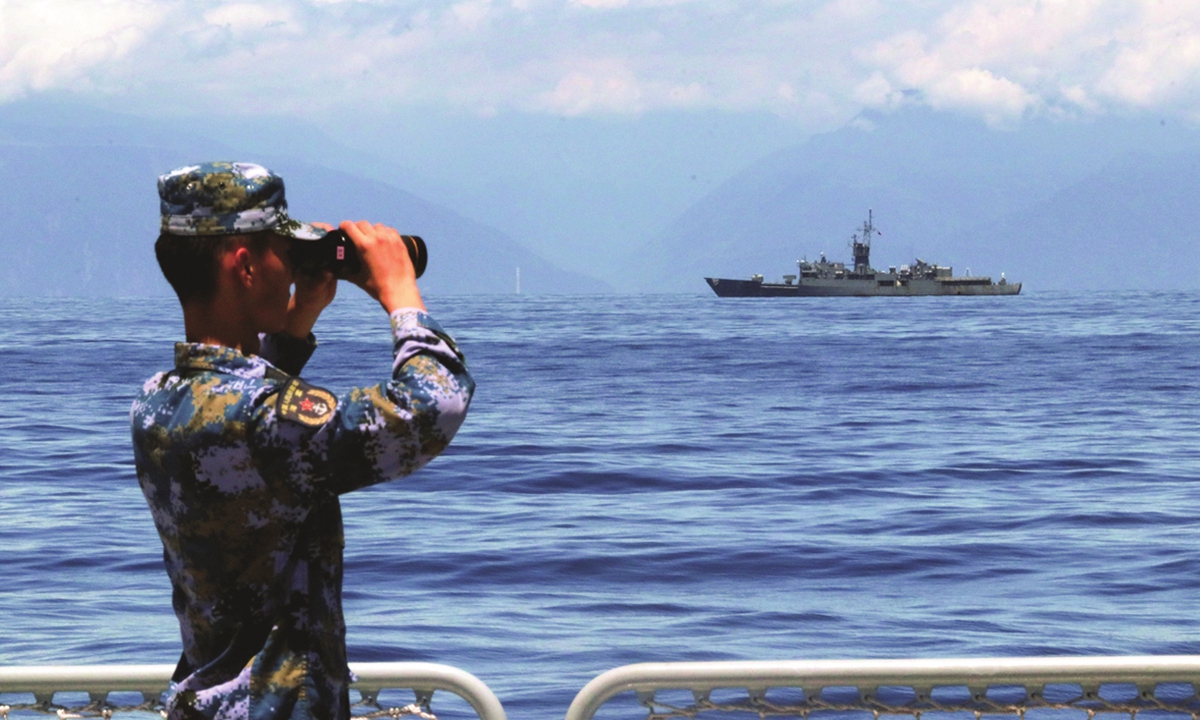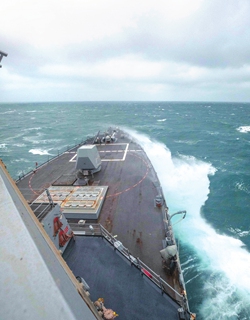
A soldier looks through binoculars during combat exercises and training of the navy of the Eastern Theater Command of the Chinese People's Liberation Army (PLA) in the waters around the Taiwan island, August 5, 2022. Photo: Xinhua
The Chinese People's Liberation Army (PLA) Eastern Theater Command monitored, tracked and maintained a high level of alert on the USS
Chung-Hoon guided missile destroyer as it transited through the Taiwan Straits on Thursday, Senior Colonel Shi Yi, spokesperson of the PLA Eastern Theater Command, said in a statement on Friday, stressing that every move made by the US vessel was under complete control of the Eastern Theater Command.
This sent a clear signal to the US that it is no longer possible for it to produce any deterrence against the Chinese mainland by sending warships through the Taiwan Straits, experts noted.
Shi's statement came after the US Pacific Fleet announced Thursday that the Arleigh Burke-class guided-missile destroyer conducted a Taiwan Straits transit on Thursday.

The US' Arleigh Burke-class guided-missile destroyer USS Chung Hoon conducts a Taiwan Straits transit on January 5, 2023. Photo: website of the US Pacific Fleet
This is reportedly the first time a US warship has transited the Taiwan Straits in 2023. Song Zhongping, a Chinese military expert, predicted more and severer moves of this kind to come in the rest of the year.
The US has made it normal to provoke China, Song told the Global Times on Friday.
"The PLA has to get prepared for military conflicts," Song said, noting that the PLA will not be afraid of any foreign military forces.
According to media reports, since 2012, US warships have transited through the Taiwan Straits nearly 100 times.
In 2021, US warships transited through the Straits 13 times, the most in 14 years, according to the think tank South China Sea Strategic Situation Probing Initiative.
In late August 2022, two US cruisers sailed through the Taiwan Straits, soon after US House Speaker Nancy Pelosi's provocative visit to the island of Taiwan.
US warships' transiting through the Taiwan Straits has become a routine performance for the US, sending provocative signals to the Chinese mainland and encouraging the Taiwan authorities by doing so. But this show has had a diminishing effect. Now, every time a US warship transits through the Taiwan Straits, PLA forces will follow and monitor it, which has become the usual scenario in the game between the two sides, observers noted.
It should be noted that it is no longer possible for the US to produce any deterrence against the Chinese mainland by sending warships through the Taiwan Straits, and its emboldening effect on Taiwan authorities is getting smaller and smaller. Its practical impact on the mainland is that we are constantly reminded that the US is a very unfriendly and obstructive force to China's reunification and that we need to give up our illusions, observers noted.
Another ironic aspect of the USS
Chung-Hoon's transit is that the ship, the US Navy's 43rd Arleigh Burke-class guided-missile destroyer, was named in honor of Rear Admiral Gordon Pai'ea Chung-Hoon (1910-1979), a Chinese-English-Hawaiian who was the first Asian American flag officer and recipient of the Navy Cross and Silver Star for conspicuous gallantry and extraordinary heroism as commanding officer for USS Sigsbee (DD 502) during battles in World War II against Japan's air attacks.
"The history of the USS
Chung-Hoon should remind some people in the US that China and the US used to be allies against fascism and Japanese militarism. Why does the US now go in the opposite direction and view China as an enemy?" Song asked, noting that using a warship named after a Chinese-American hero from WWII to provoke China leaves Chinese people feeling bitterly disappointed.
China and the US can cooperate with each other. China has never challenged the US, but the US always takes China's development as a threat, an indication of the US' lack of self-confidence, Song said.
The year 2022 witnessed intensive provocative moves by the US against the Chinese mainland over the Taiwan question, along with the US' so-called Indo-Pacific Strategy for a "free and open Indo-Pacific" that leans heavily on coordinating with its allies. It also seeks to build up a stronger presence in Southeast Asia as well as a military deterrence to counter China, which experts said is nothing but a ridiculous Biden administration fantasy filled with deceptive actions to tie Asian countries to its anti-China chariot to stir up regional turbulence.
In early August, US Speaker of the House of Representatives Nancy Pelosi visited Taiwan island despite strong opposition from the Chinese mainland, which escalated regional tensions and resulted in China-US relations plunging to new lows.
In late December, the US announced another batch of arms sales to the island of Taiwan, including anti-tank mine-laying systems, a type of weapon that can be used to slow down potential amphibious landing operations from the PLA.
Earlier that month, the US signed into law the National Defense Authorization Act for Fiscal Year 2023 on December 23, which enables the US government to finance weapons for the island of Taiwan.
Two days after the approval of the Act, the PLA organized large-scale military exercises around the island of Taiwan that were "aimed at 'Taiwan independence' secessionist moves and interference from external forces with the goal of safeguarding national sovereignty and territorial integrity," Tan said at the time.
The PLA will act wherever secessionists attempt to split the country, Tan said.





